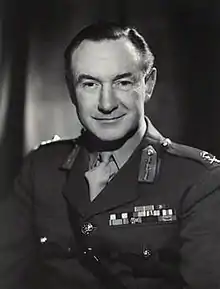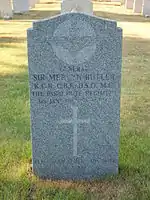Mervyn Butler
General Sir Mervyn Andrew Haldane Butler, KCB, CBE, DSO & Bar, MC (1 July 1913 – 3 January 1976) was a British Army officer who served as Commander-in-Chief Strategic Command.
Sir Mervyn Butler | |
|---|---|
 General Sir Mervyn Butler in 1967 | |
| Born | 1 July 1913 |
| Died | 3 January 1976 (aged 62) |
| Buried | |
| Allegiance | United Kingdom |
| Service/ | British Army |
| Years of service | 1933–1976 |
| Rank | General |
| Service number | 58182 |
| Unit | South Lancashire Regiment Parachute Regiment Suffolk Regiment |
| Commands held | Army Strategic Command I (British) Corps Staff College, Camberley 2nd Division 16th Independent Parachute Brigade |
| Battles/wars | Second World War Cyprus Emergency Suez Crisis |
| Awards | Knight Commander of the Order of the Bath Commander of the Order of the British Empire Distinguished Service Order & Bar Military Cross Mentioned in Despatches |
Military career
Mervyn Butler was educated at St Columba's College, Rathfarnham, Ireland and at the Royal Military College, Sandhurst.[1] He was commissioned as a second lieutenant into the South Lancashire Regiment on 4 February 1933[2][1] and was promoted to lieutenant on 2 February 1936.[3] He was again promoted, this time to captain, on 2 February 1941.[4] He transferred to the Parachute Regiment and served with distinction during the Second World War, being awarded both the Distinguished Service Order and the Military Cross for his services.[5] He transferred to the Suffolk Regiment on 20 July 1946.[6][1]
Butler commanded the 16th Independent Parachute Brigade from 1955 to 1957.[1] During the Suez Crisis elements of the 16th Independent Parachute Brigade led by Butler and a contingent of the Royal Tank Regiment set off south along the canal bank on 6 November 1956 to capture Ismailia. Just before midnight Butler was ordered to stop on the hour, when a ceasefire would come into effect. This raised a difficulty. There were Egyptian forces ahead; the British column was in open desert with no defensible feature to hand. Butler compromised, advancing until 0:15 am on 7 November 1956 to reach El Cap, where he sited the 2nd Battalion of the Parachute Regiment, with supporting detachments.[7] He was awarded a Bar to his Distinguished Service Order on 13 June 1957.[8]
Butler was General Officer Commanding 2nd Division from 1962 to 1964.[9]

In 1964 Butler was appointed Assistant Chief of Defence Studies (Joint Warfare) and then in 1966 went on to be Commandant of the Staff College, Camberley.[5] From 1968 to 1970 he was General Officer Commanding 1 (British) Corps. He was General Officer Commanding Army Strategic Command from 1970 to 1971 before going on to serve as Commandant of the Royal College of Defence Studies from January 1972 to 1973.[5] He was promoted to general on 14 January 1972.[10] He was also Colonel Commandant of the Parachute Regiment from 1967 to 1972.[11]
Butler was appointed a Commander of the Order of the British Empire for service in Cyprus in 1957,[12] a Companion of the Order of the Bath in the 1964 New Year Honours,[13] and advanced to Knight Commander of the Order of the Bath in the 1968 New Year Honours.[14]
On his death in 1976 Butler was buried in Aldershot Military Cemetery.
References
- Who Was Who Volume V11 1971–1980 (1981)
- "No. 33908". The London Gazette. 3 February 1933. p. 743.
- "No. 34253". The London Gazette. 7 February 1936. p. 820.
- "No. 35063". The London Gazette (Supplement). 31 January 1941. p. 676.
- Whitaker's Almanacks
- "No. 37657". The London Gazette (Supplement). 16 July 1946. p. 3726.
- The Oxford Illustrated History of the British Army (1994) General Editor David Chandler p. 349
- "No. 41092". The London Gazette (Supplement). 4 June 1957. p. 3419.
- Army Commands Archived 5 July 2015 at the Wayback Machine
- "No. 45604". The London Gazette (Supplement). 22 February 1972. p. 2198.
- The Red Devils GG Norton (Leo Cooper Famous Regiment Series)
- "No. 41131". The London Gazette (Supplement). 19 July 1957. p. 4361.
- "No. 43200". The London Gazette (Supplement). 31 December 1963. p. 3.
- "No. 44484". The London Gazette (Supplement). 29 December 1967. p. 3.